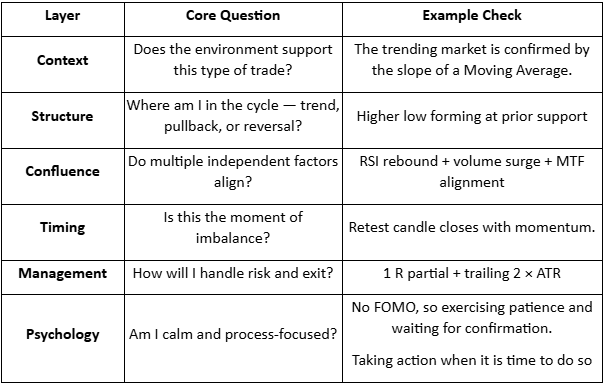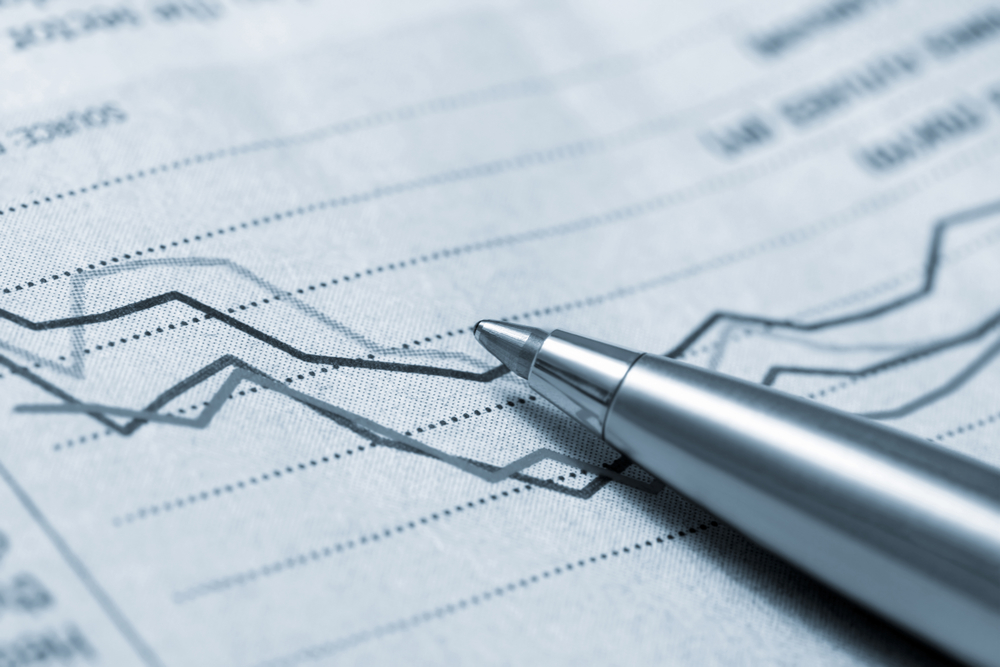Estrategias de trading para respaldar tu toma de decisiones
Explora técnicas prácticas para ayudarte a planificar, analizar y mejorar tus operaciones.

.jpg)
Every trader has had that moment where a seemingly perfect trade goes astray.
You see a clean chart on the screen, showing a textbook candle pattern; it seems as though the market planets have aligned, and so you enthusiastically jump into your trade.
But before you even have time to indulge in a little self-praise at a job well done, the market does the opposite of what you expected, and your stop loss is triggered.
This common scenario, which we have all unfortunately experienced, raises the question: What separates these “almost” trades from the truly higher-probability setups?
The State of Alignment
A high-probability setup isn’t necessarily a single signal or chart pattern. It is the coming together of several factors in a way that can potentially increase the likelihood of a successful trade.
When combined, six interconnected layers can come together to form the full “anatomy” of a higher-probability trading setup:
- Context
- Structure
- Confluence
- Timing
- Management
- Psychology
When more of these factors are in place, the greater the (potential) probability your trade will behave as expected.
Market Context
When we explore market context, we are looking at the underlying background conditions that may help some trading ideas thrive, and contribute to others failing.
Regime Awareness
Every trading strategy you choose to create has a natural set of market circumstances that could be an optimum trading environment for that particular trading approach.
For example:
- Trending regimes may favour momentum or breakout setups.
- Ranging regimes may suit mean-reversion or bounce systems.
- High-volatility regimes create opportunity but demand wider stops and quicker management.
Investing time considering the underlying market regime may help avoid the temptation to force a trending system into a sideways market.
Simply looking at the slope of a 50-period moving average or the width of a Bollinger Band can suggest what type of market is currently in play.
Sentiment Alignment
If risk sentiment shifts towards a specific (or a group) of related assets, the technical picture is more likely to change to match that.
For example, if the USD index is broadly strengthening as an underlying move, then looking for long trades in EURUSD setups may end up fighting headwinds.
Setting yourself some simple rules can help, as trading against a potential tidal wave of opposite price change in a related asset is not usually a strong foundation on which to base a trading decision.
Key Reference Zones
Context also means the location of the current price relative to levels or previous landmarks.
Some examples include:
- Weekly highs/lows
- Prior session ranges, e.g. the Asian high and low as we move into the European session
- Major “round” psychological numbers (e.g., 1.10, 1000)
A long trading setup into these areas of market importance may result in an overhead resistance, or a short trade into a potential area of support may reduce the probability of a continuation of that price move before the trade even starts.
Market Structure
Structure is the visual rhythm of price that you may see on the chart. It involves the sequences of trader impulses and corrections that end up defining the overall direction and the likelihood of continuation:
- Uptrend: Higher highs (HH) and higher lows (HL)
- Downtrend: Lower highs (LH) and lower lows (LL)
- Transition: Break in structure often followed by a retest of previous levels.
A pullback in an uptrend followed by renewed buying pressure over a previous price swing high point may well constitute a higher-probability buy than a random candle pattern in the middle of nowhere.
Compression and Expansion
Markets move through cycles of energy build-up and release. It is a reflection of the repositioning of asset holdings, subtle institutional accumulation, or a response to new information, and may all result in different, albeit temporary, broad price scenarios.
- Compression: Evidenced by a tightening range, declining ATR, smaller candles, and so suggesting a period of indecision or exhaustion of a previous price move,
- Expansion: Evidenced by a sudden breakout, larger candle bodies, and a volume spike, is suggestive of a move that is now underway.
A breakout that clears a liquidity zone often runs further, as ‘trapped’ traders may further fuel the move as they scramble to reposition.
A setup aligned with such liquidity flows may carry a higher probability than one trading directly into it.
Confluence
Confluence is the art of layering independent evidence to create a whole story. Think of it as a type of “market forensics” — each piece of confirmation evidence may offer a “better hand’ or further positive alignment for your idea.
There are three noteworthy types of confluence:
- Technical Confluence – Multiple technical tools agree with your trading idea:
- Moving average alignment (e.g., 20 EMA above 50 EMA) for a long trade
- A Fibonacci retracement level is lining up with a previously identified support level.
- Momentum is increasing on indicators such as the MACD.
- Multi-Timeframe Confluence – Where a lower timeframe setup is consistent with a higher timeframe trend. If you have alignment of breakout evidence across multiple timeframes, any move will often be strengthened by different traders trading on different timeframes, all jumping into new trades together.
3. Volume Confluence – Any directional move, if supported by increasing volume, suggests higher levels of market participation. Whereas falling volume may be indicative of a lesser market enthusiasm for a particular price move.
Confluence is not about clutter on your chart. Adding indicators, e.g., three oscillators showing the same thing, may make your chart look like a work of art, but it offers little to your trading decision-making and may dilute action clarity.
Think of it this way: Confluence comes from having different dimensions of evidence and seeing them align. Price, time, momentum, and participation (which is evidenced by volume) can all contribute.
Timing & Execution
An alignment in context and structure can still fail to produce a desired outcome if your timing is not as it should be. Execution is where higher probability traders may separate themselves from hopeful ones.
Entry Timing
- Confirmation: Wait for the candle to close beyond the structure or level. Avoid the temptation to try to jump in early on a premature breakout wick before the candle is mature.
- Retests: If the price has retested and respected a breakout level, it may filter out some false breaks that we will often see.
- Then act: Be patient for the setup to complete. Talking yourself out of a trade for the sake of just one more candle” confirmation may, over time, erode potential as you are repeatedly late into trades.
Session & Liquidity Windows
Markets breathe differently throughout the day as one session rolls into another. Each session's characteristics may suit different strategies.
For example:
- London Open: Often has a volatility surge; Range breaks may work well.
- New York Overlap: Often, we will see some continuation or reversal of morning trends.
- Asian Session: A quieter session where mean-reversion or range trading approaches may do well
Trade Management
Managing the position well after entry can turn probability into realised profit, or if mismanaged, can result in losses compounding or giving back unrealised profit to the market.
Pre-defined Invalidation
Asking yourself before entry: “What would the market have to do to prove me wrong?” could be an approach worth trying.
This facilitates stops to be placed logically rather than emotionally. If a trade idea moves against your original thinking, based on a change to a state of unalignment, then considering exit would seem logical.
Scaling & Partial Exits
High-probability trade entries will still benefit from dynamic exit approaches that may involve partial position closes and adaptive trailing of your initial stop.
Trader Psychology
One of the most important and overlooked components of a higher-probability setup is you.
It is you who makes the choices to adopt these practices, and you who must battle the common trading “demons” of fear, impatience, and distorted expectation.
Let's be real, higher-probability trades are less common than many may lead you to believe.
Many traders destroy their potential to develop any trading edge by taking frequent low-probability setups out of a desire to be “in the market.”
It can take strength to be inactive for periods of time and exercise that patience for every box to be ticked in your plan before acting.
Measure “You” performance
Each trade you take becomes data and can provide invaluable feedback. You can only make a judgment of a planned strategy if you have followed it to the letter.
Discipline in execution can be your greatest ally or enemy in determining whether you ultimately achieve positive trading outcomes.
Bringing It All Together – The Setup Blueprint

Final Thoughts
Higher-probability setups are not found but are constructed methodically.
A trader who understands the “higher-probability anatomy” is less likely to chase trades or feel the need to always be in the market. They will see merit in ticking all the right boxes and then taking decisive action when it is time to do so.
It is now up to you to review what you have in place now, identify gaps that may exist, and commit to taking action!


At the recent GO Markets Daryl Guppy seminar, we had a presentation from Daryl that covered both an insightful economic outlook as well as some of his technical trading approaches. During the seminar, a question was asked about how to match the two. i.e. if you have an economic idea how can you integrate this into your trading style. We have put together one potential approach that could be used for your consideration.
Arguably, the same rigour of process should be applied to this as with any trading strategy, and this video presentation aims to outline such a potential process. Traditionally, many Forex and CFD traders, enter short term, often intraday positions. With a longer term economic view, generally you are placing a longer term trade, based on that view with the idea that it could move in your desired direction.
As well as share holdings, this trading approach is very possible with Forex, index and commodity CFDs and of course, share CFDs with the potential advantage of being able to trade "short" easily compared to when trading shares. The video is a recording of this weeks Inner Circle session (we have edited out the market watch section of the recording to focus on the educational component). https://vimeo.com/377703349


Please find the recording of the Latest Inner Circle session, the first in our NEW interviews with successful traders series. Nigel Hawkes is the epitome of a lifetime trader, now at 71 he trades for a living. Hear his fascinating trading journey, the foundation principle of "Six ways the market moves" and his 3 golden rules he abides by in his trading on a daily basis.
You can make the video full screen by clicking on the icon in the bottom right hand corner. Couple of quick notes: a. When Nigel refers to the ES aas an instrument this is the S&P500 E-mini contract (so not dissimilar to the SP500 CFD). b.
Nigel chooses to use minutes as a personal choice not available so 240 minutes = 4 hours (not available on MT4/5). https://vimeo.com/385016331 Any comments or questions to [email protected] Don't forget the latest "Next steps" course starts next week, click HERE for more information and get on board. If you are not yet a member of "Inner Circle" don't miss out and join us (click HERE to find out more) Mike Smith Educator and course facilitator GO Markets


Another fantastic webinar session yet again, with this week's session of the Interviews with Successful Traders series featuring Mark Austin of Magnetic Trading, whose main speciality is Index trading. What Mark shared not only had relevance to Index trading, but also across all trading vehicles. We are delighted to share the video from the session which you can watch here.
There is also an opportunity to see Mark and partner Cameron Malik in action, implementing some of the trading strategies that were referenced in the session as part of a special two-week free trial of their LIVE trading room, exclusive only to GO Markets clients. Gain access here. https://vimeo.com/391110084 If you have any questions about this session, please feel free to drop a line through to me at [email protected] Trade Safe, Mike Smith Educator and course facilitator Go Markets Disclaimer The article from GO Markets analysts is based on their independent analysis. Views expressed are of their own and of a ‘general’ nature.
Advice (if any) are not based on the reader’s personal objectives, financial situation or needs. Readers should, therefore, consider how appropriate the advice (if any) is to their objectives, financial situation and needs, before acting on the advice.


Your trading plan is arguably THE most important system to have in place and having a complete and evidence-based plan may for many be a key goal to aim for in your 2020 trading journey. It should serve you in guiding your every trading action, for every vehicle, in entry, intra-trade management and exit. We want to help you achieve this aim.
We have discussed on many occasions how making each statement sufficiently specific and unambiguous will not only enable you to develop the consistently that most experienced traders suggest is crucial for long-term positive outcomes but will facilitate measurement so you can amend your plan to better fit your individual trading style. This week GO Markets Inner Circle session tackled this topic head on. Find below the video from last nights Inner Circle session "How to make your trading plan potentially serve you better in 2020?" You can watch with 'full screen' by clicking on the icon in the bottom left corner. https://vimeo.com/380241718 If you want to join us for future "Inner Circle" sessions please feel free to CLICK HERE to find out more and register to join this growing trading education community.
Mike Smith Educator GO Markets


We frequently refer both in the articles we publish and the weekly “Inner Circle” sessions we present, to the benefits of a trading journal. However, the reality is that many traders make the choice not to measure trading despite the logical benefits of doing so. Whether you do or don’t currently, the bottom-line decision you are making is not only whether you do or don’t but how that positions yourself with your trading development.
We would suggest that this overall choice can be broken down into the following three sub-choices. You can make the decisions that are right for you subsequently. Sub-choice 1 – Measuring your system You are either making the choice to: Have certainty on not only whether your trading plan as a whole can create positive outcomes but have evidence to know which component parts of your plan are e.g. indicators you use for entry and exit, comparing strategies you trade, timeframes that work best for you, (and which are not) contributing to such outcomes.
Additionally, it allows you to compare what would happen if you change some of the perimeters on your potential results. OR You have no evidence as to whether your system as a whole and its components parts are working well to serve you in getting the results you desire. Nor do you can test and gather evidence as to what the impact of nay changes you may make to that system, Ask yourself… If I am serious about trading results which choice should I make?
Sub-choice 2 – Measuring you as a trader You are either making the choice to: Know the degree to which you are following your plan or otherwise so you can ultimately make a judgement on: a. Whether your system is working for you (all the points in sub-choice 1 above CANNOT be made unless you are following your plan religiously). b. What you need to work on in terms of tightening your behaviour e.g. on exits or entry c.
Whether there are certain market conditions which you find difficult or are ill-prepared for (so you can fill any knowledge gaps or avoid in the future). OR You can continue to trade as you do, avoiding any self-assessment and growth, and the refinement of your behaviour that may contribute to more positive trading outcomes. Ask yourself… If I am serious about trading results which choice should I make?
Sub-choice 3 – Improving your trading (closing the circle) (let’s assume you are keeping a journal for this one) You are either making the choice to: Measure with purpose that has clear follow through into further development and refinement of your trading plan and subsequently your actions. This facilitates the development of you as a trader based on your individual character and trading style. In practical terms, you ‘close the circle’ with a defined review and develop an action plan based on your review to test and change parts of your plan.
This is evidence-based trading! OR You can measure for measurements sake to on the surface appear to be “doing a right thing” but in reality, failing to unleash the real power of journaling, that is to make an on-going and continuous positive difference to your trading outcomes. Ask yourself… If I am serious about trading results which choice should I make?
In summary, if you have made the choice to read this article to its end you are left with one ultimate choice…to journal or not to journal including the three sub-choices that dependent on which you are making can impact on your trading. So, for one last time, Ask yourself… If I am serious about trading results what should my actions be with what I have read in this article? Our next steps and Share CFD education programme both have indicative trading journal templates to help get you started, and we would be delighted if you could join us.
Mike Smith Educator GO Markets Disclaimer The articles are from GO Markets analysts based on their independent analysis. Views expressed are of their own and of a ‘general’ nature. Advice (if any) are not based on the reader’s personal objectives, financial situation or needs.
Readers should, therefore, consider how appropriate the advice (if any) is to their objectives, financial situation and needs, before acting on the advice. Find additional Forex trading education resources here. Next: 5-point checklist for using chart patterns within your tradin


Success leaves clues, and over the years as an educator and coach, I can confidently say that there are several things that traders who achieve positive trading outcomes appear to do, that less successful traders are not doing. One of these is to have a daily agenda or habits that go alongside direct trading activities with the aims of getting and staying in the optimum “state” to trade and to facilitate consistency in action. Here are 5 observations to consider… #1 – Check in on your potential “trading state” before you look at the market We have discussed in previous articles the advantages of making decisions when you are in an optimum state to do this.
I highly recommend you read my 10 Ways to Manage Your Trading Psychology – a Blueprint for Development post if you haven't already. If one constantly interacts with the market, consistent and constructive action may be more difficult. Therefore, logically "checking in" where you are before you start your trading day becomes even more necessary.
It may be there are things going on in your non-trading world that are significant enough to be a justifiable distraction and require attention, or you are not in the best of health. However, it's important to realise that the markets WILL always be there. There are times when it is good to trade and times when you should give yourself permission not to. #2 – Re-align with trading purpose and plan at the start of your trading day Your trading purpose, or your reason for trading, is your start point for developing strategies that are consistent with your trading objectives.
Your trading plan is your “guiding light” in making this purpose happen. Every trading decision should relate to these, and without it, traders have a lower chance of creating the trading outcomes they desire. In the “heat of the market”, it is easy to get “sucked in” to the price action of open trades as you see your trading capital moving up and down.
Without the explicit instruction of a pre-prepared plan, it becomes more difficult to maintain the consistency and clarity that it is already characteristic of experienced traders. Touching base, or re-aligning with these at the start of your trading day offers a reminder as to the why and how you will think, decide and act in the hours to come. #3 – Make a judgment on what to expect Every day the market throws up different challenges, different price movements, volatility, and new economic information, influencing overall market sentiment. Advanced traders take the time to make an overview judgment on what is happening and adjust decisions on time-frames traded, risk level or chosen strategies, accordingly.
For example, one of the possibilities we have discussed in a previous article and in Inner Circle sessions is the concept of adjusting risk level according to the strength of the signal or underlying market conditions. What we mean by this is that if our normal tolerable risk level is 2% of our trading account capital on each trade as a standard and we note increased market uncertainty indicated by higher price volatility, but identify a potential opportunity for entry, we may adjust that risk level to 1% in light of this observation. Having a system to make a judgment prior to trading allows this sort of approach to be taken, making it an unquestionable attribute of an experienced trader. #4 – Check in with yourself at key points during your trading day Your emotional state can, and often will change throughout your trading day, primarily dependent on either the results you are getting or your judgment on performance.
We are all familiar with the concept of ‘revenge trading’ if a trade, or series of trades move against you. This is at the extreme end of capital damaging emotional state. Equally and more insidiously dangerous is a succession of wins or losses where your consistency may waver, either originating from a belief that you can perhaps “feel the market” or begin to doubt yourself as a trader.
A potential solution is to have it written in your plan that if either of these scenarios is the case, then you could move away from the market for a period of time, enabling you to reset, re-align and revisit the market later on with a refreshed sense of purpose and plan. #5 – Review your day including completion of journaling tasks Formal review of performance is a critical part of on-going trading development. We have discussed many times the benefits of keeping a journal record of your trades, within not only measure outcomes, but the decisions that were taken to create these. Completing your journal daily may identify common threads of both things that went well (and you can mirror going forward) as well as potential areas for development.
Experienced traders who do this give themselves that important chance of sustainable growth which appears to be a key factor in long term trading outcomes. To summarise, you always have a choice as to whether you integrate what you read into your trading. In this case, it is the choice of having a daily agenda that can contribute positively to your long term trading strategy.
Every week I run education webinars offering innovative and comprehensive learning across all aspects of trading knowledge and practice. If you would like to expand your knowledge and build your confidence as a trader while also connecting with other Forex and CFD traders, register here.

